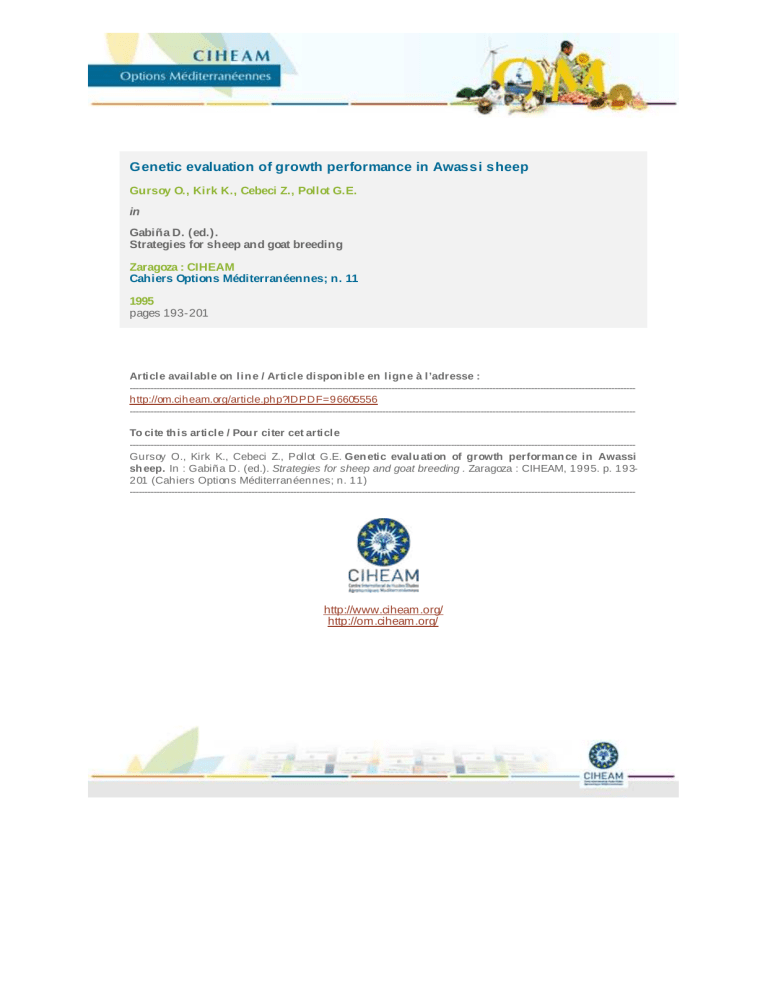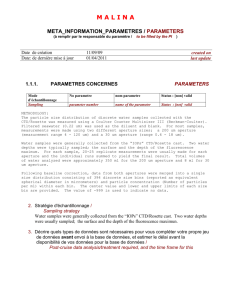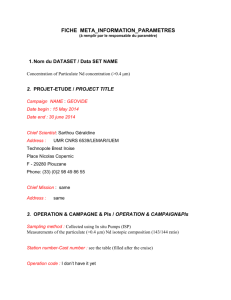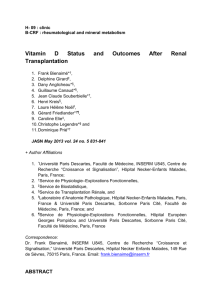Genetic evaluation of growth performance in Awassi sheep pages 193-201
advertisement

Genetic evaluation of growth performance in Awassi sheep Gursoy O., Kirk K., Cebeci Z., Pollot G.E. in Gabiña D. (ed.). Strategies for sheep and goat breeding Zaragoza : CIHEAM Cahiers Options Méditerranéennes; n. 11 1995 pages 193-201 Article available on lin e / Article dispon ible en lign e à l’adresse : -------------------------------------------------------------------------------------------------------------------------------------------------------------------------http://om.ciheam.org/article.php?IDPDF=96605556 -------------------------------------------------------------------------------------------------------------------------------------------------------------------------To cite th is article / Pou r citer cet article -------------------------------------------------------------------------------------------------------------------------------------------------------------------------Gursoy O., Kirk K., Cebeci Z., Pollot G.E. Gen etic evalu ation of growth performan ce in Awassi sh eep. In : Gabiña D. (ed.). Strategies for sheep and goat breeding . Zaragoza : CIHEAM, 1995. p. 193201 (Cahiers Options Méditerranéennes; n. 11) -------------------------------------------------------------------------------------------------------------------------------------------------------------------------- http://www.ciheam.org/ http://om.ciheam.org/ CIHEAM - Options Mediterraneennes Genetic evaluation of growth performance in Awassi sheep O. GURSOY K. KIRK Z. CEBECI DEPARTMENT OF ANIMAL SCIENCE FACULTY OF AGRICULTURE UNIVERSITY OF ÇUKUROVA ADANA TURKEY G.E. POLLOT W E COLLEGE UNIVERSITY OF LONDON W E , ASHFORD, KENT UNITED KINGDOM - SUMMARY A total of 1090 male and female Awassi lamb records were analyzed for pre-weaning growth performance and genetic parameters. Results indicated that progeny of Israeli rams were significantly heavier than pure Turkish Awassi at birth andweaning (70 days). Slightly higher pre-weaning daily gain observedforthe offspring of the Israeli. rams were notfound to be significant. Hertabilities estimated from paternal half sibanalyses were found to be 0.16, 0.22 and 0.20 for birth weight, weaning weight andpreweaning daily gain. Birth weight was seentohavea moderate genetic correlation with weaning weight (61.6%) and preweaningdaily gain (49.5%). The genetic correlation between weaning weight and the preweaning daily gainwas 99%. Postweaning growth performance and genetic parameterswere estimated using the feedlot data of 309 male lambs fattened-along with the 11 male lambs of the State Farm. Sire lines were not found to be significant but the malelambs of theIsraeli rams were 1.27 kg heavier than the pure Ceylanpinar lambs. Heritability of the final feedlot weight was found to be0.35 and post-weaning dailygain 0.10, the latterbeing surprisingly low. Both genetic and phenotypic correlations between finalweight and postweaning daily gain were found to be high. words: Awassi, genetic parameters, growth, progeny test RESUME - Au total1090 d'agneaux mâle ef femelle de races Awassiontété analysés afin deconstaterlapetformancedecroissancepré-sevréeetles paramètresgénétiques. Les resultats obtenus indiquent que la progéniture des béliers israéliens est plus lourde que celle de la race pure Awassi Turque à la naissance et au sevrage (70 jours). Le gainde poids quotidienau post-sevrage étant Iégerement plus 'élevé pour les descendances des béliers israéliens n'a pas été trouvésignificatif.Les héritabilités estimées à partirdesdonnés du demi-sang paternal ont été trouvées de 16, et pour le poids a la naissance] le poids au sevrage et la gain de puids quotidien au pré-sevrage. Le poids à la naissance peut avoir un niveau moyen de la corrélation génétique avec la poids au sevrage (61.6%) et le gain de poids au pré-sevrage(49.5%). La corrélation génétique entre le poids au sevrage et le gain de poids au pré-sevrage est de l'ordre de 99%. La petformance de croissance au post-sevrage et les paramètres génétiques ont été CIHEAM - Options Mediterraneennes estimés en employant donnés les d'engraissement des 309 d'agneaux mâles engraissés avec l7 d'agneaux mâles de la Ferme de I'Etat. Les lignées mâles n'ont pas été trouvées significatives et les agneaux mâles des béliers israéliens sont kg de plus lourd que les agneaux pures de la race pure Awassi Turque. L'héritabilité du poids final dans 129 jours a été trouvé de et le gain de poids quotidien de O, I O au post-sevrags est faible d'une façon étonnante. Les corrélations genétique et phénotypique entre le poids final et le gain de poids au post-sevrage ont été trouvés hautes. Mots-clés :Awassi, paramètres génétiques, croissance, test de la descendance. INTRODUCTION Awassi is a dairy sheep breed and is the predominant breed in Southeast AnatoliaaswellastheArabianpeninsula,PalestineandIsrael.Awassisheep, imported from Turkey, were found to produce more milk and grow faster than the local varieties in Iraq and Syria (Al-Raw¡ et a1,1994; Bahhady et al, 1994a; Bahhady et al,l994b). The Awassi olso It proved to be a good sire breed in improving milk production of the crosses with other local breeds in different countries (Epstein,l985; Eliçin and Ertugrul, 1994). Breedingeffortshavebeenconcentratedonmilkratherthangrowth. In recentstudies,lambsfromtheCeylanpinarpopulationinTurkeyshowedfeedlot performance of over g daily -gains (Görgülü and Öztürkcan,l994; Özcan et al, 1994). Thes2 results indicate that mean growth performance is comparable to many well known meat breeds. Thus the Awassi is not only a good milker but may also be considered as being a good fattening material. A reasonably fast growth is the key to profitability of the sheep operations. Under harsh conditions of the South Eastern Turkey, Syria, Iraq, Jordan and Israel Awassi can solve meat shortages if their growth and reproductive performance are imgroved not. Growth performancz in Awassi, measured as postweaning weight gain (feed lot trials) shows great variation asis the case in lactation yields ( 97.5 - 469.0 kg).Henceselectionforgrowthperformancemayyieldbetterperforming'Awassi because heritability of growth is known to be higher than milk production. A better idea may be the inclusion of growth performance in the selection index of the rams along with the milk production. In the ongoing project on "Genetic Selection for Milk Yield in Awassi Sheep" candidate rams are being tested using AI. Growth performance of the progeny of the tested rams were recorded. The objective in this study was to estimate heritabilities,genetic and phenotypic correlations of birth weight,weanining weight(70 days) and feedlot final weight (129 days), preweaning and postweaning daily gain (feedlot). MATERIALS AND METHODS Data were obtained from Awassi sheep flock keptat Ceylanpinar State Farm (CSF) in Sanliurfa province of Turkey. Beginningin 1992, a progeny testing scheme was initiated using genetic selection for milk yield in Awassi sheep, after determining theexistenceofhighvariationinlactationyieldsoftheCeylanpinarpopulation 194 CIHEAM - Options Mediterraneennes (Gürsoyetal.1992). In theselectionprogramme,lambgrowthdatawerealso recorded and used for the analysis of growth performances of Awassi sheep. ResearchersinIsraelreporttheexistenceofimprovedAwassiflockswith mean lactation yields exceeding 500 kg (Epstein,l985). So 5 improved rams were imported from Israel for comparative purposes. During the mating season 4 Israeli Awassi rams and 17 Ceylanpinar yearlings from the top producing Ceylanpinar ewes were used for artificially inseminating approximately 150 yearlings per ram at random in July/August1992.Thenumberofeweslambingper 100 ewesmatedwas approximately 60%. All the lambs were reared under similar conditions until weaning. Following weaning the male lambs were put on feedlot along with 11000 the male lambs of the production flocks. The lambs were born between mid December 1992 and end of January 1993. Birth weights were recorded within 24 hours of birth. For preweaning evaluation, the studied traits were birth weight(BW), weaning weight (WW) and preweaning daily gain (PWDG) for both sexes of lambs. Since weighings were made on 54 and 101 days. fixed days rather than at fixed ages, weaning ages varied between Therefore, adjustments were made to standard (mean) age of 70 days for the traits of weaning weight and pre-weaning daily gain. Pre-weaning daily gain was calculated as difference between weaning and birth weight divided by weaning age. After excluding twins and triplets a total of 1090 male and female lamb records were avaliable for the analysis of pre-weaning traits. In order to evaluate post weaning performance, 309 male lambs were taken to a feed!ot experiment after weaning. The weaning weight taken on a fixed date for all thelambswasconsideredastheinitialfeedlotweight.Thefeedlotperiodlasted between 44 and 61 days due to the varying ages of lambs. At the end of feedlot period the lambs were weighed and recorded as final weight (FW). Feedlotdaily gain (FLDG) was calculated as the difference between initial weight (weaning weight) and final weight divided by the days in feedlot. Analysis of variance The mixed model least squares analysis and maximum likelihood computer programmewrittenbyHarvey(1987)wasusedtoanalysethedata. In orderto estimate the effects of sire line and sex of lamb on birth weight, weaning weight and pre-weaning daily gain the following mixed model (Model 1) was used: In the models above: : Observed pre-weaning traits recorded onph lamb with kth sex, sired byfh sire of ifh line, Trait 1 (BW) : Birthweight(kg), Trait 2 (W) : Weaning weight adjusted to standard age of 70 days (kg), 195 ey CIHEAM - Options Mediterraneennes Trait 3 (PWDG) : Pre-weaning daily gain (g), Yijl : Observed feedlot traits recorded on ph lamb with sired byfh sire of ifh line, Trait 4 (FW) : Final weigth at the end of feedlot period (kg), Trait 5 (FLDG) : Feedlot daily gain (g), : Oerall mean, Li : Fixed effect of ifh sireline, Sj:i : Random effect of fh sire nested within fh line, Sj:i (O, o : Fixed effect of kth sex of lamb, bj : Regression coefficient of initial feedlot age for Model 2, b2 : Regression coefficient of days on feed for Model 2, : initial feedlot age (days), zijkl : Days on feed (days), eijkl : Random residual term, eijkr (O, o',). - In the models studied, line difference was tested against the sire within line effect.Thesignificanceofallothertermsweretestedagainsttheerrormean squares. Heritabilities, phenotypic and genetic correlations Heritabilities, 'phenotypic and genetic correlations between traits were estimatedfrompaternalhalf-sibdata,sirecomponentsofvariance ( G ~ ~and ) covariance(CovsXY)with 17 degreesoffreedomandresidualcomponentsof variance and covariance (COVeXY) with 1071 degrees of freedom. In order to estimate genetic parameters considered, the principles employed were similar to the by "Model 3 given RESULTS AND DISCUSSION Pre-weaning traits The effect of sire lines wasfoundtobehighlysignificantforbirthweight (p<O.O01) andsignificantforweaningweight(pc0.05).However, it wasnonsignificant for pre-weaning daily gain (Table 2). As it is seen in Table 1, mean birth weight of the lambs sired by Israeli rams exceeded by 0.43 kg the lambs sired by Turkish Awassi rams. At weaning the difference between sire lines was0.90 kg and relatively lower than that of birth weight indicating that the sire effect decreased significantly as lambs got older. The difference between the sire lines may have originated from the relatively greater size of the Israeli rams either selected for size or rared intensively. Their average weight at mating time was 117 kg as comparedto the77kgoftheCeylanpinarAwassiwhicharefedverylittlesupplementafter weaning until their first mating at 18 months. As expected,sex of lambs had also highly significant effect on all the preweaning traits (p<O.OOl; Table 2j. Indicating that adjustment of pre-weanning data forsexoflambisanecessaryprocedureforcorrectestimationofthegenetic parameters and precise selection of the best rams. l i CIHEAM - Options Mediterraneennes Table 1. Least sauares means and standard errors for birth weight (BW), weaning Overall Line Israel Turkish Sex Male Female 1090 4.35 16.89 f .20 181.89 f .O4 4.56 269 f .O6 17.34 k.36 185.71 .O3 4.13k 821 5344.47 f .O4 5564.22 .O4 2.55 f 4.58 16.44 178.06 .20 17.48 .22 16.29 k .22 k 2.51 187.53 2.77 176.23 f 2.74 Table 2. Least squares analysis of variance for birth weight (BW), weaning weight (W)and pre-weaning daily gain (PWDG). Level of significance Source of. BW d.f. W PWDG variance *** * 1 ns lines Sire Sires lambsof Sex ***: pc0.001, 17 *** *** *** 1 *** *** *** ns: not significant The use of Israeli rams at Ceylanpinar was based on the assumption that the highperformanceofIsraeliAwassiformilkyieldwasduetosuperiorgenetic componentforthistrait.Theresultsreported in thispaperareafirststepto investigating the extend of this assumed genetic superiority. In the current study, the use of genes from Israeli-Awassi was limited to half those in the recorded rowing lambs. At young ages lamb growth is dominated by the maternal environment, particularly milk yieldof the mother, and the genetic potential of the lamb for early growth is masked by these somewhat greater Influences. Table3.Heritabilities,phenotypicandgeneticcorrelationsbetween BW ww Traits BW .l6 ww .62-22 f.23 PWDG .99 k.28 -30 f .1 PWDG .l 1 -99 +.O1 1) Heritabilities, genetic and phenotypic correlations are shown on,. below and above diagonal, respectively. As it isseen in Table 3, estimatesofheritability,geneticandphenotypic 197 CIHEAM - Options Mediterraneennes correlations were significant for all 'pre-weaning traits. The heritability estimate of birth weight was higher than those found in the studies by Bowman and Broadbent (1 966); Thrift et al. (1973); Gjedrem(l967); Erkje (1974), and lower than those found by Olson et aL(1976); Vogt et al. (1967); Osman and Broadford (1965); Owen et al. (1978); Mavrogenis et al. (1980); Qureshi et al., (1987), however, nearly similar to found by Martin et al. (1980) and Shelton & Campbell (1962). The heritability for weaning weight standardized to 70 days of age was found to be low when compared to the findings in many previous studies carried out on various sheep breeds. However,it seemed to be higher than those found by Thrift et al. (1973); Vogt et al. (1967); Mavrogenis et al. (1980). Theheritabilityestimateforpre-weaningdailygainwasfoundlowerthan those found in the other studies. Mavrogenis et al. (1980) found a higher estimate (0.36) in Chios sheep and Qureshi et a1.(1987) found 0.27 for Awassi sheep. Birth weight had a moderate genetic correlations with weaning weight and pre-weaning daily gain whereasit was found to be very high between the latter traits. The heritabilities of the early growth traits were low but consistent with other reports from similar flocks analysed by paternal half-sib least squares techniques. There is clearly some genetic influence of the lamb on its own growth but recent studies using animal model techniques and an additional maternal component of variance have highlighted the effects of the ewe on these traits. Under the conditions of Ceylanpinar the greatest response in early lamb growth 'will come from selecting ewes for improved milk production and rams for post-weaning growth rate. Thegeneticcorrelationsbetweentheearlylambtraitsareconsistentwith other reports, the closer the weights in time the higher the the correlations. The very high correlation between weaning weight and pre-weaning daily gain is not surprising in the the inclusion of birth weight since they are almost the same trait., differing only in weaning weight. Feedlot traits In the feedlot experiment only the male lambs were considered because in Ceylanpinar female lambs are not fattenned. So the actual weaning weights were taken as the initial feedlot weight. The lambs had arying ages, between 54-101 days with a mean of 73 days at weaning. The lambs were weight.once at the end of the feedlot period of 44-61 days with a mean lamb age of 129 days. Theeffectofsireline wassignificantforweightsatbirthandweaning, whereas it was non-significant for feedlot final weight and feedlot daily gain (p>0.05). As seen in Table 5, sire effect was also insignificant for feedlot daily gain (p>0.05) but significant for final weight (pc0.05). Unlike the pre-weaning traits a ecreasing influence of sire line was observed. As the lambs grow, effects of line growth in the post-weaning (feedlot) period become non- significant.. This may be partly due to thelevelofprecisionofthetrialwithlimitednumbersonthefeedlottrialand considerable variation .in age and weight at the start of the feedlot. However, it may alsobetheresultofthelimitinginfluenceoftheeweandtheenvironmentat Ceylanpinar not allowing the full potential of the Israeli bred lambs to show. In a 198 CIHEAM - Options Mediterraneennes recent study at the Univrsity of Cukurova Görgülü and öztürkcan, reported fairly, high daily gains g) for the weaned lambs purchased at random from Ceylanpinar. Daily gains of approximately g obtained in this study indicate that the feeding regime provided to the mass number of lambs (II000) at the feedlot failed to meet the nutritional requirements of the lambs. Despite this, Israeli-bred lambs were kg heavier at the end of the feedlot period and showed consistently superior, but non-significant, growth throughout the trial. Least squares means and standard errors for final weight- (FW), daily . and ,. gain in feedlot period (FLDG) for the male lambs. Effect Table n Overall Lines Israeli t Turkish 1 t Regressions feedlod Initial age t feed onDays -0.068 t The regression of initial feedlot age on the final weight indicates that for every day increase in the initial feedlot age final weight increased by kg. It also had an effect on the feedlot daily gains by roughly g. Days on feed had Table 5. Least squares analysis of variance of final weight at the end feedlot (FW) and feedlot daily gain FLDG) for the male lambs. Level of significance variance d.f of Source lines W ns Sire 1 Sires FLDG ns **X ns Regressions Coef.(Linear) Initial feedlot age feedon Days -: p<O.OOI, an effect of daily gain. 1 X** *** 1 *** ns ns: not significant kg on the final weight but very little negative effect on the feedlot The heritability -for feedlot daily gain was very low (Table 6) comparedto values reported in other studies. This may be due to the small variance of the sire component found for this trait. CIHEAM - Options Mediterraneennes Table 6. Traits FW FLDG .35 (FW) weigth Final rt . l 8 .77 rt .22 .IO? .l1 Daily gain in feedlot(FLDG) .94 1) Heritabilities,geneticandphenotypiccorrelationsareshown and above diagonal, respectively. on, below Thegeneticandphenotypiccorrelationswerefoundtobehighindicating close relation between these two traits. CONCLUSIONS IsraeliAwassirams,assumedtobesuperiortoTurkishramsforlactation traits, were found to be superior for birth and weaning weights, however, they were notsuperiorforfeedlottraits.Anothertrialwithhighernutritionalstatusmaybe necessary in) order to test their feedlot performance along with the contemporary pure Turkish Awassi. A more eloborate analyses of 1992/93, 1993194 and 1994/95 data will give better picture of their actual merits. According to the results, since the heritabilities were low for both pre-weaning and feedlot (postweaning) traits it will not be appropriate to select according to individual merits.Thereforeprogenytestingmaybemoreeffectiveinimprovinggrowth performance in Awassi sheep. The high estimates of genetic correlations between weaning weight and preweaning daily gain point that selection based on weaning weight can provide enough progress for the pre-weaning daily gain. Similar remarks are valid for the traits of feedlot final weight and feedlot daily gain. REFERENCES Al-Rawi,A.R., Al-Salman,M.H. Al-Azzawi,W.A. and Hadeethi,H.A. 1994. Sheep improvement in the Mashreq Project in Iraq. Crop and Livestock Improvement in MashreqRegion.ProceedingsoftheMashreqProjectWorkshoponlncresed Productivity of Barley, Pastures and Sheep in the Critical Rainfall Zones. 13-15 Dec. 1992,Amman, J0rdan.p. 191 -198. Bahhaby,F.,Goodchild,A.,Heritani,A.andTreacher,T.I994a.Comparisonofthe performance of Turkish and Syrian s t a r k of Awassi ewes. Proceedings of the Workshop on the Strategies for the Development of Fat-tail Sheep in the Near East. Oct.5-9,1992. Adana,Turkey. EAAP Publication No:68: 70-73. Bahhahy,F.,Goodchild,A.,Heritani,A.andTreacher,T11994b.Comparison of the performance of TurkishandSyrianstrains of Awassiewesattwolevelsof nutrition. Crop and Livestock Improvementin Mashreq Region.Proceedings of the MashreqProjectWorkshoponlncresedProductivityofBarley,Pasturesand Sheep in the Critical Rainfall Zones. 13-1 5 Dec. 1992,Amman, Jordan.p.230-236. Bowman,J.C. and Broadbent,J.S. 1966. Genetic parameters of growth between birth and sixteen weeksin Down cross sheep. Anim. Prod.8:129-135. CIHEAM - Options Mediterraneennes Eikje,E.D.1974.Studiesonsheepprodüctionrecords.IV.Genetic,phenotipicand environmental parameters for weight of lambs. Acta Agric. Scand. 24:291-298. Eliçin, A. andErtugrul,M.1994.ImportanceofAwassisheepinaridandsemi-arid regions.Proceedings of the Workshop Strategies for the Development of Dat-tail Sheep ¡.n the Near East. Oct.5-9,1992. Adana,Turkey. EAAP Publication No:68: 41-48. Epstein,H.1985. The Awassi sheep with special reference to the improved dairy type. FAO Animal Production and Health Paper 75. FAO, Rome. Gjedrem,T.1967.Phenotypicandgeneticparametersforweightoflambsatfive ages.Acta Agric. Scand. 17:199-216. Görgülü,M.andÖztürkcan,O.1994.Effectsofdietaryenergya'ndproteinlevelson fatteningperformanceofAwassilambs.ProceedingsoftheWorkshoponthe Strategies for the Development of Fat-tail Sheep in the Near East. Oct.5-9,1992. Adana,Turkey. EAAP Publication No:68: 66-69. Gürsoy,O.Pekel,E.,Özcan,L.,Torun O. and Timon,V.1992. Genetic selection for milk yield in Awassisheep. 1:Reproductionandlactation.Dosa-Tr.J.Vet.Anim.Sci. 161535-546. Harvey,W.R.,1987.Themixedmodelandmaximumlikelihoodcomputerporgram (LSMLMW). Polycopy. Ohio State Univ. Phenotypic and genetic Martin ,T.G.,Sales,D.I.,Smith,C.and Nicholson,D.1980. parameters for lamb weights in a synthetic of line sheep. Anim. Prod. 30:261-269. Mavrogenis,A.P., Louca,A., Robison, O.W., 1980. Estimates of genetic parameters forpre-weaningandpost-weaninggrowthtraitsofChioslambs.AnimalProd., 30:271-276. Olson, L. W., Dickerson, G.E. and Glimp,H.A. 1976. Selection critaria for intensive market lamb production: growth traits. J. Anim. Sci. 43:78-89. Osman,A.H.andBradford,G.E.1965.Effectsofenvironmentonphenotypicand genetic variation In sheep. J.Anim.Sci. 24:766-774. Owen, J.B. ,Brook,L.E., Read,J.L.Steane,D.E. and Hil1,W.G. 1978. An evaluation of performance-testing of rams using artificial raring. Anim. Prod. 27:247-259. Özcan,L.,Gürsoy,O.,Pekel,E.,Torun,O.1994.Growthperformance andcarcass merits of Turkish Awassi sheep. Proceedings of the Workshopon the Strategies for the Development of Fat-tail Sheep in the Near East. Oct.59,1992. Adana,Turkey. EAAP Publication No:68: 57-63. Qureshi,M.A., Ahmad,M., Ahmad,Z., Khan,M.A., Ahmad,M.K.1987. Genetic studies onAwassisheep in Pakistan.Heritabilityestimatesofsomeproductivetraits. Sarhad J.Agr. 3 (4):441-446. Shelton,M. and Campbell,F.1962. Influence of environmental adjustments on heritability of weaningWight of range Rambouillet lambs. J.Anim.Sci. 21:91-94. Thrift,F.A.,Whiteman,J.V.andKratzer,D.D.1973.Geneticanalysisofpreweaning and postweaning lamb growth traits.J. Anim. Sci. 36: 640-643. Vogt,D.W., Carter, R.C. and McClure, W.H.1967. Genetic and phenotypic parameterestimatesinvolvingeconomicallyimportanttraitsinsheep.J.Anim. Prod. 26: 1232-1238. 201


